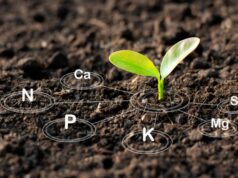Summary: Screening for drought tolerance is severely handicapped by the lack of simple and reliable phenotyping techniques. The objective of this study was to develop a new phenotyping technique for mung bean based on seedling survivability, score of drought tolerance, root and shoot length, fresh and dry weight of roots and shoots under hydroponic condition.
Its effectiveness was compared with two soil culture techniques. In hydroponic technique, 15 days old mung bean seedlings of 32 genotypes were lifted up from nutrient solution and exposed to air for 5 h daily for a period of 8 days as compared to control.
Genotypes ‘Pant Mung-5’ and ‘Pusa 871’ showed maximum seedling survivability and minimum reduction in the growth parameters (root and shoot length, fresh and dry weight of roots and shoots) with a score of 0.08 indicating their higher tolerance to drought stress while genotypes ‘Pusa 031’ and ‘IPM02-3’ showed no seedling survivability and maximum reduction in the growth parameters (root and shoot length, fresh and dry weight of roots and shoots) with a drought score of 3.0 indicating low drought tolerance.
The results suggest that this new phenotyping technique is effective, rapid and easy for screening a large number of genotypes. The additional advantage of this technique is that the seedlings can be used for further progeny testing and selection.
Introduction
Drought is one of the major abiotic stresses that limit plant growth and productivity in many areas of the world. The development of drought–hardy cultivars of crops through selection and breeding is of vital importance for extending crop areas under low rainfall conditions or in areas lacking appropriate irrigation system .
Various screening techniques have been developed based on physiological/biochemical and morphological traits under soil conditions.
However, most of these techniques are not very efficient and reliable for screening a large number of plants. Keeping this in view, we have developed a new phenotyping technique using hydroponics to screen a large number of plants at early stage of growth for drought tolerance in mung bean.
Results
The effects of stress were observed after 1h air exposure on the leaves which became wilted (Fig 2).

The highly susceptible lines showed wilting much before (within 1hr) tolerant lines. All the genotypes wilted when their plants were exposed to air for 5 hr and when returned into the nutrient solution for 12 hr. only the highly tolerant genotypes (Pant Mung-5 and Pusa 871) showed much faster recovery.
However, susceptible genotypes (Pusa 031 and IPM02-3) did not show any recovery when reverted to the nutrient solution (Fig.3).

Differences among the genotypes became conspicuously visible and progressively more pronounced with advancing days of root exposure to air. Complete seedling death began in 6 days in susceptible genotypes.
This means that the 5 hr exposure to stress resulted in complete breakdown of plant metabolism in the sensitive genotypes, which was not the case with drought tolerant genotypes. The exposure of air did not damage the basic metabolism and the plants still retained the capacity to bounce back to normal life when water became available.
This, together with the yellow brown leaves with severe wilting symptoms developed in Pusa 31 and IPM02-3 indicates a greater susceptibility of young plants to short period of air exposure. The genotypes Pant Mung-5 and Pusa871 showed maximum seedling survivability and minimum reduction in the root and shoot length and fresh and dry weight of root and shoot with a score of 0.08 and were found to be tolerant.
However, Pusa 31 and IPM02-3 showed no seedling survivability and maximum reduction in the root and shoot length and fresh and dry weight of roots and shoots with a score of 3.0.

Based on seedling survivability (%), drought score and growth parameters, we identified two highly drought tolerant genotypes (Pant Mung-5 and Pusa 871) and two highly susceptible genotypes (‘Pusa 031’ and ‘IPM02-3’) among the 32 genotypes.
By:
D. Singh1, H.K. Dikshit1 and R. Singh2
- Division of Genetics, Indian Agricultural Research Institute, New Delhi-110 012.
- Water Technology Centre, Indian Agricultural Research Institute, New Delhi-110 012









